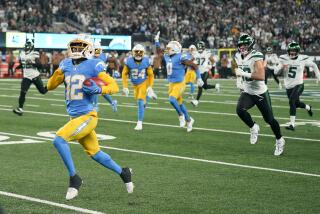Changing Quickly
The speed revolution in the NFL started on offense. Check out an old game on cable. See those two guys behind the quarterback? Used to be like that all the time. That’s not a woolly mammoth on the edge. That’s what defensive ends used to look like and, come to think of it, move like. And no, you’re not seeing un-double; there are only two receivers. Seems almost quaint now. Son, in my day, fullbacks played every down and even carried the ball sometimes! And our linebackers were as big as a Mack truck and half as mobile!
The NFL is at about the fifth permutation of the speed revolution -- and there’s more going on right now. First, spread formations begot faster offenses. In response, defensive backs and linebackers got faster. Offensive linemen were next, followed closely by suddenly quick defensive ends. Or maybe that last one is the other way around. It’s sometimes hard to tell who’s zooming who. Meanwhile, the emerging change has wicked-fast tight ends forcing free safeties to be bigger and strong safeties to be faster, to the point that the differences among safeties, linebackers and cornerbacks are getting fuzzy.
Quarterback Michael Vick, middle linebacker Brian Urlacher, tight end Jeremy Shockey and defensive tackle Warren Sapp have set new standards for their positions. Opponents try to counter, but there’s only so much a team can do against guys with freakish skills -- aside from finding new guys with more freakish skills.
Want an example of how challenging it is to play against speed? Let’s say a team sics a guard on Urlacher. If that guard can get by a sticky-fingered defensive tackle, and if he reaches Urlacher, and if the play is going right at Urlacher, maybe he’ll be neutralized. If those ifs aren’t met ...
“Oh, geez. He can run with probably any back in this league. He’s a freak, in my opinion,” Packer offensive line coach Larry Beightol says of Urlacher.
For teams trying to keep up, it’s an ongoing battle. As offenses succeed because of the way they use speed, defenses change in response. Defenses need linebackers who can range from sideline to sideline and cornerbacks who can cover fleet receivers one-on-one. It works the other way too. As defensive ends become smaller and faster, offensive coaches seek tackles who sacrifice size for quickness and mobility. Not all the changes brought on by speed are as clear as the blur in Vick’s wake; there are subtle changes, too, from faster snaps to faster thinking to faster cadence. Players even develop more quickly. Does anybody really believe Carson Palmer will be Jon Kitna’s caddie all season?
The increased speed is not solely attributable to faster players. Indeed, some veterans say players haven’t gotten faster; the way the game is played has. More guys swarm to the ball now, and nobody takes plays off. “You can’t plod through the games anymore. You have to be fast and play fast,” says Giants quarterback Kerry Collins.
Ready for a contradiction? Good. For elite players, the faster the game gets, the slower it seems to them. Kurt Warner says that as the Rams’ passing game gets quicker, it appears slower and clearer to him. “Things happen more distinctly,” he says. “It just opens the field up.”
Now watch when the season starts. What will you see? One running back, about a bazillion wide receivers, a fullback, maybe, and he’ll play like a cross between a tight end and a fullback. On the other side of the ball, there likely will be seven guys between the hash marks; there used to be nine. And everybody will play at speeds unheard of just a few years ago.
That football has gotten faster in the last decade -- and will continue to do so -- is inarguable. You can see the speed, feel the game’s faster rhythm and, if you’re close enough, hear it. The footsteps are lighter, more sure. There’s still plenty of grunting and groaning, but it sounds less like a woolly mammoth and more like a woolly mammoth chasing and catching a gazelle.
More to Read
Go beyond the scoreboard
Get the latest on L.A.'s teams in the daily Sports Report newsletter.
You may occasionally receive promotional content from the Los Angeles Times.










